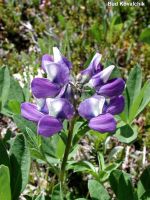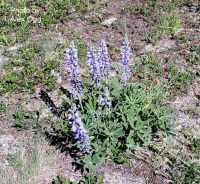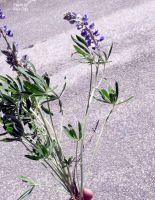Distribution: Occurring east of the Cascades crest in Washington; British Columbia to southern Washington, east to the Rocky Mountains and Nevada..
Habitat: Open areas from low to moderate elevations, including the subalpine.
Flowers: May-July
Origin: Native
Growth Duration: Perennial
Conservation Status: Not of concern
Pollination: Bumblebees, bees, flies, butterflies, beetles, wasps
Pubescent perennial, the stems 4-5 dm. tall, simple, not hollow.
Basal leaves numerous, their petioles 3-6 times as long as the blades; cauline leaves with petioles much reduced upward, often shorter than the blades; leaflets 9-11, narrow, linear-oblanceolate, usually abruptly acuminate, 2-4 cm. long and 2-6 mm. wide, grayish to yellowish on both sides.
Inflorescence of racemes borne well above the leaves, 1-5-2.5 cm. long, many-flowered; pedicles 5-10 mm. long; flowers 11-16 mm. long, deep violet or purple, the banner often reddish, yellowish, or with a white center; calyx stiff-hairy to silky, the upper lip shallowly bi-dentate; banner glabrous, well reflexed; wings glabrous; keel with marginal hairs.
Pods hairy, 2.5-4 cm. long.
Publication: Great Basin Naturalist 46: 257. 1986.
Lupinus humicola A. Nelson
Lupinus rydbergii Blank.
Lupinus wyethii S. Watson [HC]
Lupinus wyethii S. Watson ssp. wyethii
PNW Herbaria: Specimen records of Lupinus polyphyllus var. humicola in the Consortium of Pacific Northwest Herbaria database
WA Flora Checklist: Lupinus polyphyllus var. humicola checklist entry
OregonFlora: Lupinus polyphyllus var. humicola information
E-Flora BC: Lupinus polyphyllus var. humicola atlas page
CalPhotos: Lupinus polyphyllus var. humicola photos























